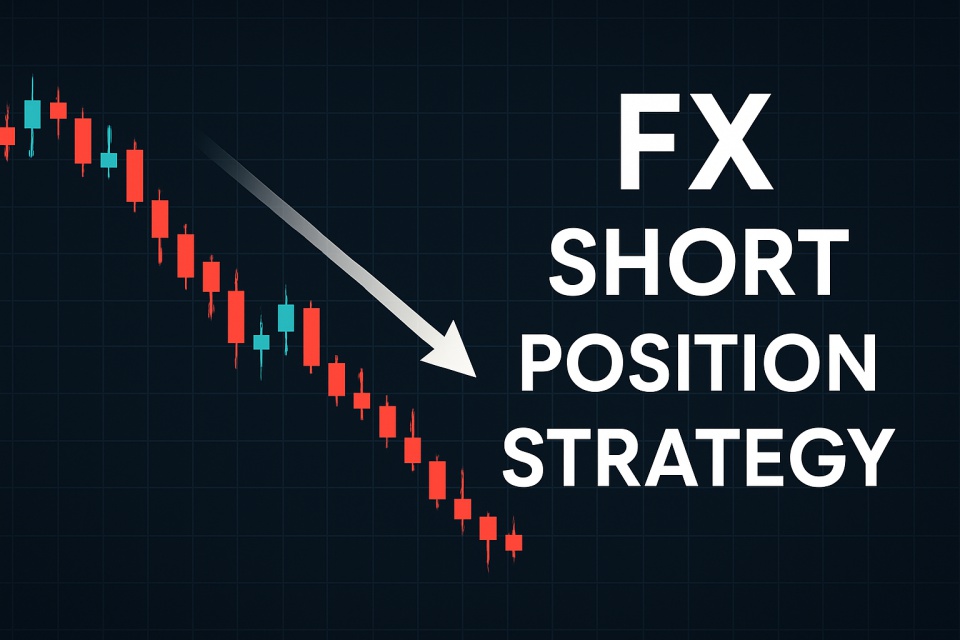- 🟦 Introduction: Why Understanding Short Positions Matters in Forex
- 🟦 Chapter 2: What Is a Short Position? Definition, Mechanism, and Basic Terms
- 🟦 Chapter 3: Short vs. Long: Key Differences and When to Use Each
- 🟦 Chapter 4: How to Execute a Forex Short Trade: Step-by-Step for Beginners
- 🟦 Chapter 5: Why Short Trades Feel Difficult: Psychological and Technical Hurdles
- 🟦 Chapter 6: Understanding Short Covering: Market Surges and Forced Buybacks
- 🟦 Chapter 7: Risks of Holding Short Positions Long-Term: Swaps and Trend Reversals
- 🟦 Conclusion: Turning Short Trades into a Strategic Advantage
🟦 Introduction: Why Understanding Short Positions Matters in Forex
In the world of forex trading, most beginners start with long positions — buying a currency in the hopes that its value will rise. But what happens when markets decline, or when a particular currency is expected to weaken?
This is where short selling comes into play — a strategy that allows traders to profit from falling prices.
Understanding short positions is not just about knowing how to “sell first and buy later.” It’s about learning how to trade in both directions, adapting to different market conditions, and managing risk effectively.
Many successful traders don’t rely solely on bullish trends. Instead, they identify opportunities in downtrends, reversals, and overbought markets using short strategies.
Yet for many, shorting remains a misunderstood or even intimidating concept, due to psychological bias and lack of clear education.
This guide is designed to change that.
Whether you’re a complete beginner or someone familiar with long trades but hesitant about shorting, this article will walk you through:
- What short positions are, and how they work in forex
- Key differences between long and short trades
- How to enter and exit short trades properly
- Common pitfalls, including swap costs and sudden reversals
- How to recognize and benefit from short covering
- Strategic use of short positions, including long-short pair strategies
By mastering short positions, you unlock a full spectrum of trading possibilities — allowing you to operate with confidence in both bullish and bearish markets.
Let’s dive in.
🟦 Chapter 2: What Is a Short Position? Definition, Mechanism, and Basic Terms
A short position in forex refers to a trade where you sell a currency first, expecting its value to decline, and then buy it back later at a lower price to make a profit. This is the opposite of a long position, where you buy first and sell later.
🔹 How Does a Short Position Work?
Let’s use USD/JPY as an example:
- You open a short trade by selling USD and buying JPY.
- If the USD/JPY rate drops, it means the dollar has weakened against the yen.
- You then close the position by buying back the dollar at a lower price.
- The difference between your sell price and buyback price is your profit.
Example:
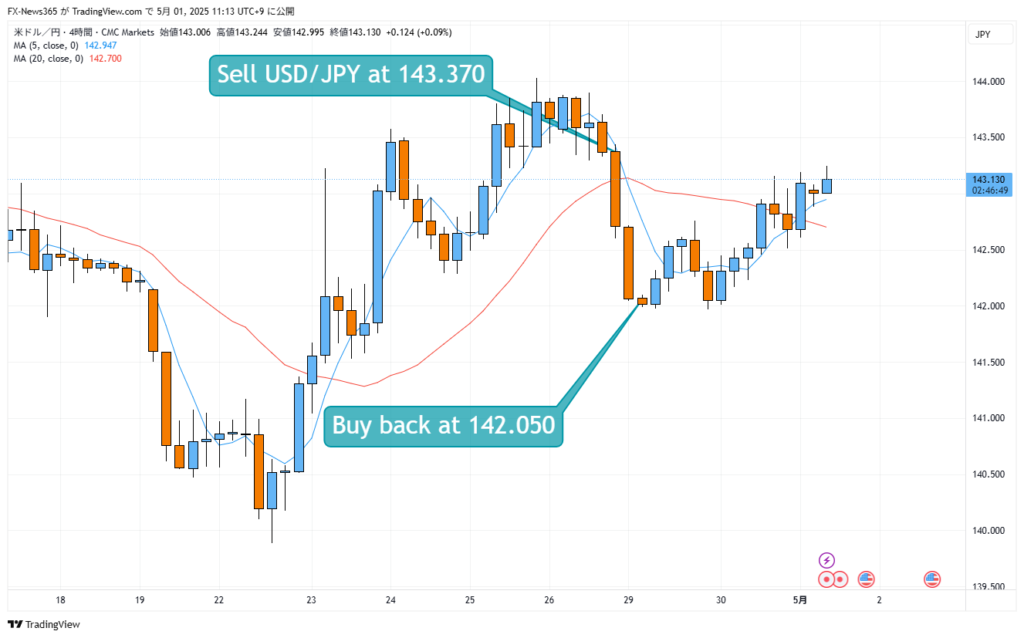
- Sell USD/JPY at 143.370
- Buy back at 142.050
- Profit: 1.32 yen per dollar traded
In forex, you don’t need to “own” the dollars to sell them. That’s because FX trading is based on margin and contract-for-difference (CFD) principles. You’re not physically exchanging currencies — you’re speculating on price movements and settling the difference in value.
🔹 Why You Can Sell What You Don’t Own
This is one of the most confusing points for beginners.
In the stock market, short selling usually requires borrowing shares before selling.
But in forex, due to its two-currency pair structure, every trade is simultaneously a buy and a sell — just on different sides of the pair.
When you short USD/JPY, you are buying JPY while selling USD at the same time.
This dual structure is what makes shorting in forex seamless and accessible, even for retail traders using platforms like MT4, MT5, or TradingView.
🔹 Key Terms to Know
| Term | Meaning |
|---|---|
| Short Position | Selling a currency with the intention to buy it back at a lower price |
| Long Position | Buying a currency expecting its price to rise |
| Short Covering | Buying back the currency to close a short trade (often seen during rapid price rebounds) |
| Stop Loss | A pre-set level where a short trade is closed to limit losses if the market moves up |
| Take Profit | A target level where the trade automatically closes to secure gains |
Understanding the mechanics of short positions is the foundation for using them effectively.
Next, we’ll compare short and long trades, so you can decide which strategy fits best depending on the market conditions.
🟦 Chapter 3: Short vs. Long: Key Differences and When to Use Each
In forex trading, every position is either long (buy) or short (sell). Understanding the difference between the two — not just in mechanics, but in strategy and psychology — is essential to becoming a flexible, market-ready trader.
🔹 What Is a Long Position?
A long position means you’re buying the base currency of a pair, expecting it to rise in value relative to the quote currency.
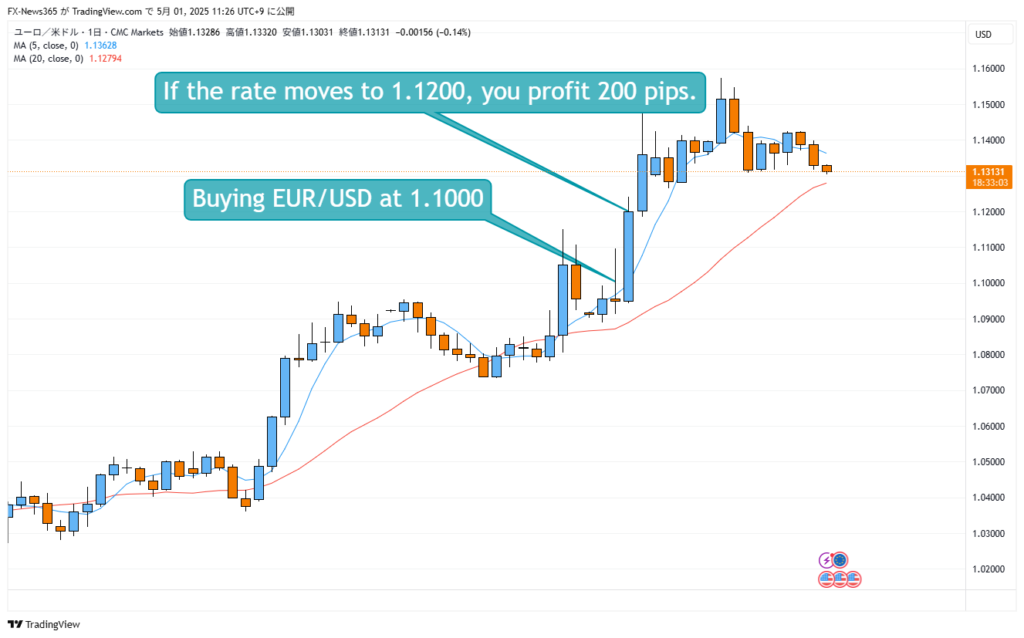
Example: Buying EUR/USD at 1.1000
→ You expect the euro to strengthen against the dollar.
→ If the rate moves to 1.1200, you profit 200 pips.
This is the default mindset for most beginners, and it aligns with how people think in everyday life: buy low, sell high.
🔹 What Is a Short Position?
A short position means you’re selling the base currency, expecting it to fall in value relative to the quote currency.
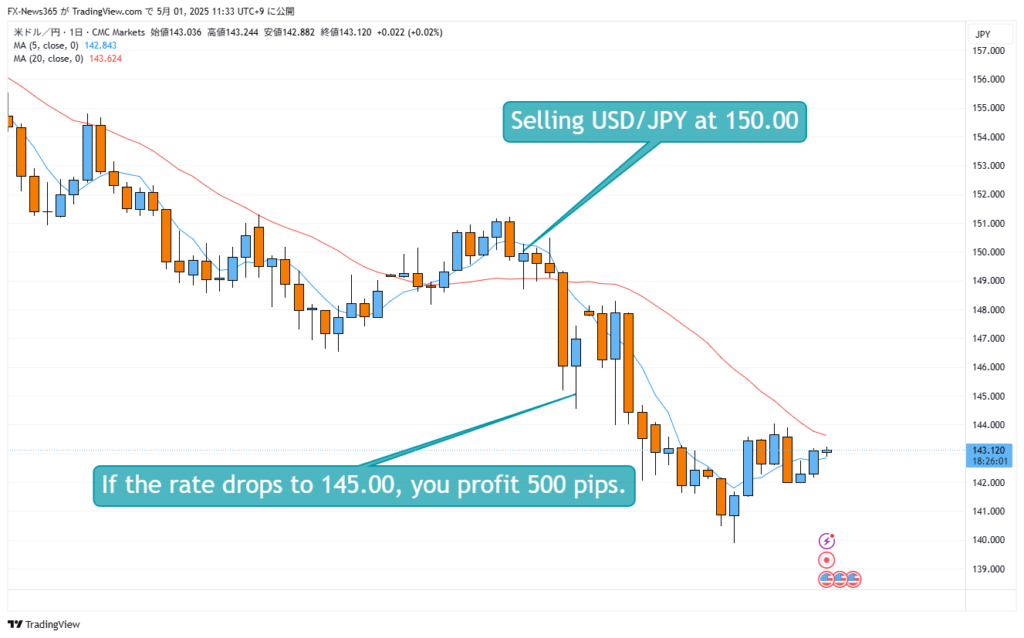
Example: Selling USD/JPY at 150.00
→ You expect the dollar to weaken against the yen.
→ If the rate drops to 145.00, you profit 500 pips.
Shorting flips the logic: sell high, buy low. While just as valid as a long trade, many new traders struggle to see price drops as profit opportunities.
🔹 Quick Comparison Table
| Feature | Long (Buy) | Short (Sell) |
|---|---|---|
| Market Direction | Bullish (rising) | Bearish (falling) |
| Profit Condition | Price goes up | Price goes down |
| Entry Action | Buy the base currency | Sell the base currency |
| Exit Action | Sell the base currency | Buy back the base currency |
| Common Bias | Feels “natural” | Often feels “counterintuitive” |
| Swap Implications | Often earns interest | Often pays interest (negative swap) |
🔹 When Should You Use a Short vs. Long Trade?
Use a long position when:
- You expect bullish news (e.g. rate hikes, positive GDP)
- The pair has broken out above resistance
- Technicals confirm upward momentum
Use a short position when:
- You expect bearish sentiment (e.g. risk-off mood, policy easing)
- The pair is in a downtrend or hitting resistance
- Sentiment shows overbought conditions or negative divergence
📌 The key is flexibility.
Many beginner traders get stuck thinking “buy only.” But market professionals succeed by adapting their strategy to market direction, not personal preference.
In the next chapter, we’ll get practical and walk through how to actually place a short trade — step by step.
🟦 Chapter 4: How to Execute a Forex Short Trade: Step-by-Step for Beginners
Now that you understand what a short position is and how it compares to a long trade, let’s walk through how to actually place a short trade in forex.
While the concept may sound intimidating, the execution process is simple — especially on modern trading platforms like MT4, MT5, or TradingView.
🔹 Step 1: Choose the Right Currency Pair
Before entering a short trade, you must select a currency pair where you believe the base currency will weaken.
Example: You think the USD will fall
→ Short USD/JPY
→ You are selling USD and buying JPY
💡 Tip: Look for fundamental or technical signs of weakness — such as dovish central bank signals, risk-off sentiment, or bearish chart patterns.
🔹 Step 2: Open the Order Window and Select “Sell”
Most trading platforms offer two primary buttons:
- Buy (Long)
- Sell (Short)
Click on Sell to open a short position at the current price (market order) or set a specific price level (limit/stop order).
✔ If you’re a beginner, start with a market order to enter immediately, or a limit sell if you want to enter at a higher level.
🔹 Step 3: Set Your Lot Size Carefully
Forex is traded in lots. Common lot sizes are:
| Lot Size | Units of Base Currency | Value per Pip (on USD pairs) |
|---|---|---|
| 1.0 | 100,000 | ~$10 |
| 0.1 | 10,000 | ~$1 |
| 0.01 | 1,000 | ~$0.10 |
💡 Always calculate your risk per trade before entering.
A stop-loss of 50 pips at $1/pip means risking $50.
🔹 Step 4: Set Stop-Loss and Take-Profit Orders
Short trades can move quickly — in either direction. Always protect your position.
- Stop-Loss: A price above your entry, to cap losses if the market goes up
- Take-Profit: A price below your entry, to lock in gains when your target is reached
✔ These should be placed at the same time as your entry.
🔹 Step 5: Monitor the Trade and Exit Strategically
Once your short position is live:
- Watch for economic data or news that could move the market
- Reassess the trend if price action changes
- Don’t hesitate to manually close the position if the trade invalidates
📌 To exit the short, simply place a buy order for the same amount of currency.
This “buyback” closes the trade and locks in your profit or loss.
📝 Example Short Trade in Action
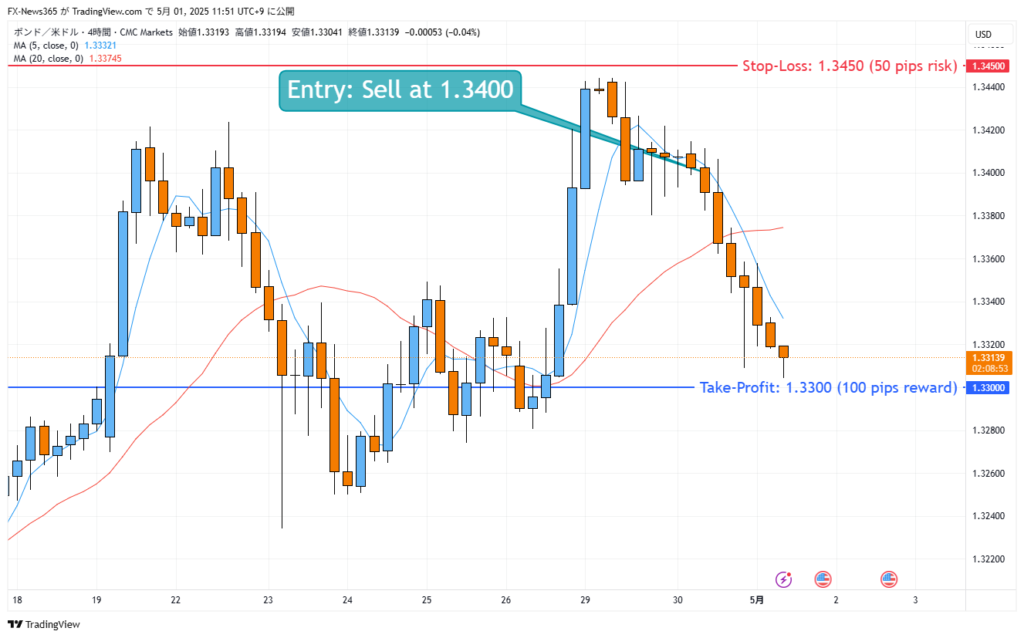
- Pair: GBP/USD
- Entry: Sell at 1.3400
- Lot Size: 0.1
- Stop-Loss: 1.3450 (50 pips risk)
- Take-Profit: 1.3300 (100 pips reward)
💰 Result: If the price falls to 1.2600, you earn ~$100. If it rises to 1.2750, you lose ~$50.
In the next chapter, we’ll explore why short trades often feel more difficult, and how to overcome that barrier — both mentally and strategically.
🟦 Chapter 5: Why Short Trades Feel Difficult: Psychological and Technical Hurdles
Many forex traders — especially beginners — find short trades more intimidating than long ones.
But why is that? The mechanics are the same. The profit potential is equal.
And yet, selling first and buying later just doesn’t feel as natural.
In this chapter, we’ll break down the core reasons why short positions often feel harder to execute, and how you can mentally and technically overcome these hurdles.
🔹 1. Psychological Bias Toward Buying
Human psychology is wired around acquiring things, not selling what we don’t own.
In everyday life, you buy a product, expect its value to increase (or deliver benefit), and eventually let it go.
In trading:
- Buying = ownership
- Selling = giving something away
Shorting flips that instinct — and it creates discomfort.
“How can I sell something I don’t have?”
“Isn’t it risky to bet against the market?”
💡 Reframe the narrative: A short trade is not a gamble — it’s a market-neutral decision based on evidence, just like a long trade.
🔹 2. Fear of Sudden Reversals and Short Covering
Short trades are more exposed to rapid market reversals, especially due to short covering (forced buybacks of short positions).
- You’re selling into what might be a support zone
- If sentiment changes or news breaks, the rebound can be fast
- This creates a fear of “getting squeezed”
This fear often leads traders to:
- Avoid short setups entirely
- Set stop-losses too tight
- Exit early even when the setup is still valid
💡 Solution: Study support levels, volume spikes, and trader sentiment to reduce surprises — and size your positions conservatively.
🔹 3. Swap Costs for Holding Shorts
In many cases, shorting high-yield currencies means paying negative swap (overnight interest).
This creates a subtle bias: long trades might “earn” you interest, but shorts “cost” you to hold.
Example: Shorting AUD/JPY might generate -JPY1,615(≒$11)/day in swap
Over two weeks, that’s -JPY22,610($158) — even before considering market movement
💡 Workaround: Trade short-term or choose low-swap pairs for shorts (like USD/CHF or EUR/USD)
🔹 4. Perceived “Unnaturalness” of Falling Markets
Traders are bombarded with media language like:
- “The market is crashing!”
- “Volatility spikes on the downside!”
- “Panic selling grips investors!”
This language paints bearish moves as “dangerous” or “abnormal,” making traders subconsciously associate downward price action with fear — even though they can profit from it.
💡 Remember: Downtrends are often faster than uptrends, offering high R:R opportunities for short trades — if you’re prepared.
🧠 Summary: Shorting Isn’t Hard — It’s Just Unfamiliar
| Obstacle | Solution |
|---|---|
| Selling feels unnatural | Reframe as strategic positioning |
| Afraid of fast reversals | Use proper stop-loss & risk size |
| Negative swap costs | Trade short-term or low-swap pairs |
| Emotional market headlines | Focus on charts, not narratives |
With education and practice, short trades become a powerful tool, not a risky exception.
🟦 Chapter 6: Understanding Short Covering: Market Surges and Forced Buybacks
Ever seen a currency pair suddenly spike upward — even though there was no obvious good news?
That may have been caused by short covering, a powerful market phenomenon where traders rush to close their short positions, triggering a wave of buying that pushes prices sharply higher.
Understanding short covering is essential not just to avoid getting caught in it — but also to profit from it.
🔹 What Is Short Covering?
Short covering happens when traders who hold short positions buy back the currency they sold, in order to exit their trades. This buying pressure can cause prices to rise — sometimes rapidly.
It’s essentially a “panic buy” to exit a short position.
Reasons for short covering include:
- Unexpected bullish news
- Price hitting key support levels
- Overcrowded short positioning (too many traders betting against)
🔹 Real-World Example
Imagine traders have heavily shorted USD/JPY, expecting the dollar to fall. Suddenly, a surprise interest rate hike by the Fed causes the dollar to strengthen.
- Shorts are in loss territory
- Margin calls or stop-losses trigger
- Traders rush to buy back the dollar to close their positions
- This buying frenzy fuels an upward spike
This is short covering in action.
🔹 Short Covering vs. New Buying
It’s important to distinguish:
- Short covering = Closing existing short trades (forced buying)
- New buying = Traders initiating fresh long positions
Short covering is usually fast, sharp, and sometimes irrational, since it’s driven by urgency, not opportunity.
🔹 How to Spot Potential Short Covering Zones
| Indicator | What to Look For |
|---|---|
| Overcrowded positioning | Market sentiment data (e.g. COT reports) showing excessive shorts |
| Price compression | Long wicks, small candles, low volatility — suggesting a squeeze setup |
| Unexpected bullish catalyst | Surprise data, central bank moves, geopolitical shifts |
| Key technical support level | Areas where price previously reversed |
📌 A bounce from a strong support zone with high volume is often a red flag for short covering.
🔹 Can You Profit From Short Covering?
Yes — if you’re early and recognize the setup.
Two main strategies:
- Fade the shorts: Go long when you suspect a squeeze is imminent.
- Look for stop-hunt patterns and failed breakdowns.
- Get out quickly: If you’re short and suspect a covering wave is starting, close your position before getting hit harder.
🧠 Key Takeaway: Short Covering Is Fuel — Learn to Respect It
Short covering isn’t just noise — it’s one of the most explosive drivers of price reversals in forex.
- It explains sharp, seemingly irrational spikes
- It punishes crowded trades and overconfidence
- It rewards those who read market structure and sentiment
🟦 Chapter 7: Risks of Holding Short Positions Long-Term: Swaps and Trend Reversals
Short trades can be profitable — but holding them for extended periods introduces unique risks that are often overlooked, especially by newer traders.
Two of the biggest pitfalls? Negative swap costs and unexpected trend reversals.
Let’s explore why short positions are often better suited for short-term strategies, and how to mitigate risk when you hold them longer.
🔹 1. Swap Costs: The Invisible Drain on Profit
In forex trading, you pay or receive swap (rollover interest) when you hold a position overnight.
With short trades, you often end up paying the interest — especially if you’re shorting a high-yield currency.
Example:
- You short AUD/JPY (selling AUD, buying JPY)
- AUD has a higher interest rate than JPY
- You pay a negative swap each night the trade is open
Over a week or month, these small charges add up and can eat into your profits — or deepen your losses.
| Pair | Typical Short Swap (Example) |
|---|---|
| AUD/JPY | -$11.26/day per 1.0 lot |
| USD/CHF | -$17.46/day per 1.0 lot |
| GBP/USD | -$3.93/day per 1.0 lot |
💡 Check the swap conditions with your broker before entering long-term short trades.
🔹 2. Trend Reversals: Shorts Are Vulnerable to Bounces
Short trades profit from declining prices, but no market falls forever.
- Price hits a major support zone
- Sentiment shifts (central bank hints, policy changes, data releases)
- A short squeeze or reversal starts
- Your position is now against the trend — and may reverse hard
📌 Unlike long positions, which tend to rise gradually, downtrends often reverse sharply, turning short-term winners into overnight losers.
Example:
- You short EUR/USD at 1.0500
- Price falls to 1.0300 (profit), but
- ECB makes a hawkish surprise → EUR rallies to 1.0600
- Your profit evaporates — and becomes a loss
🔹 3. Psychological Strain: Watching Profits Shrink
Holding a short trade long-term often creates emotional stress, especially when:
- Price stalls but swap keeps eating into your account
- The market ranges without clear momentum
- You “hope” it keeps falling — instead of reacting objectively
💡 Solution: Set clear exit plans before entering. Don’t hold just because you’re in the green — protect realized gains.
✅ Best Practices for Managing Long-Term Shorts
| Practice | Benefit |
|---|---|
| Monitor swap rates regularly | Avoid unnecessary funding losses |
| Use trailing stop-loss orders | Lock in profits as price falls |
| Watch for sentiment shifts | React early to reversal signs |
| Prioritize short-term setups | Reduce exposure to overnight risk |
| Avoid holding into major news | Prevent reversal shocks |
🧠 Summary: The Longer You Hold a Short, the More Precision You Need
Short trades are often better as agile, responsive plays, not “set and forget” positions.
Negative swaps and sudden bounces mean your timing must be sharper, and your exit strategy tighter, than with typical long trades.
🟦 Conclusion: Turning Short Trades into a Strategic Advantage
Short selling in forex isn’t just a technical function — it’s a mindset shift.
For many traders, mastering short positions marks the transition from directional bias to strategic flexibility.
It opens up a new side of the market, allowing you to operate effectively in both rising and falling conditions.
🔹 Key Takeaways from This Guide
- A short position allows you to profit when prices fall — by selling first and buying back later.
- It’s the mirror image of a long trade, but often feels harder due to psychological and structural factors.
- Shorting is not riskier — but it requires faster reactions, careful sizing, and awareness of short covering.
- Swap costs and trend reversals can erode gains if you hold shorts too long without a plan.
- You can elevate your strategy by incorporating long-short pairs, sentiment analysis, and exit discipline.
🔹 Why Most Traders Avoid Shorting — and Why You Shouldn’t
Many beginners focus solely on buying, avoiding short trades out of fear, confusion, or habit.
But that mindset ignores half the market’s opportunity.
Markets don’t only go up.
They range. They reverse.
They collapse — and then bounce.
By learning to short, you double your tactical arsenal.
🔹 Final Tip: Make Shorting Part of Your Normal Routine
The best traders don’t ask:
“Should I go long or short?”
They ask:
“What is price telling me — and what’s the best way to express that?”
When short setups align with your technicals, your risk plan, and your market thesis — don’t hesitate.
Treat shorts as just another tool in your kit, not a special-case trade.
🧠 Summary: Profit Is Not Directional — It’s Strategic
In forex, success comes not from always being right, but from being ready for anything.
Short positions let you respond with speed and precision when the market turns.
Master them — and you’ll stop reacting to the market, and start trading with control.
